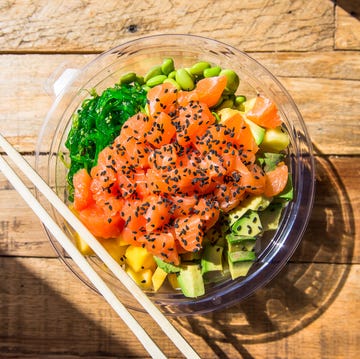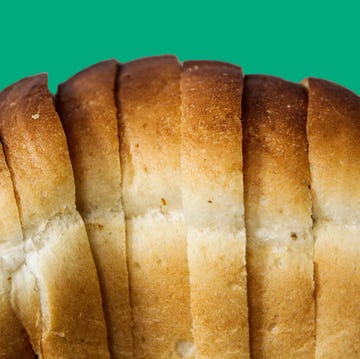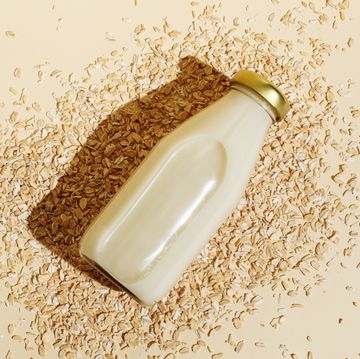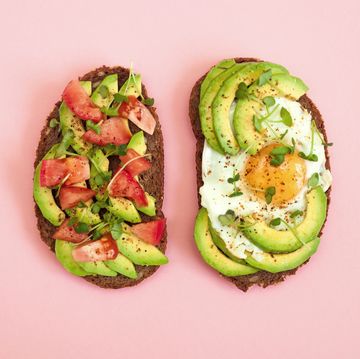One way or another, you’ve probably heard of the Zone Diet.
Maybe it was through one of its celebrity followers; Jennifer Aniston, Sandra Bullock, and Demi Moore have all been rumored to be fans. Maybe you overheard people talking about it at your local CrossFit box; the CrossFit Journal once wrote that the Zone Diet “closely models optimal nutrition."
Either way, the Zone Diet was created by Barry Sears, Ph.D, formerly a research scientist at the Boston University School of Medicine and the Massachusetts Institute of Technology, to help people lose weight and lower their risk of chronic disease by reducing diet-induced inflammation.
According to Sears, “the zone” is a physiological state in which your body is primed to control inflammation. It’s determined by three clinical markers (all of which can be measured either by your doctor or through a test available on the diet’s website) that measure insulin and other inflammation-promoting hormones. By keeping your body in this zone, the Zone Diet results in losing one to two pounds per week—or that's at least what its proponents claim.
The Zone Diet is often called a fad diet, despite its 30-year history and three New York Times best-selling books. This year, it tied with three other diets to be named the 22nd best overall diet (out of 40 diets) evaluated in the U.S. News & World Report’s Best Diet Rankings of 2018—meaning it likely won't hurt your health, but it might not be your best option.
(Speed up your progress towards your weight-loss goals with Women's Health's Look Better Naked DVD.)
What Does Inflammation Have to Do with Weight?
For one, research has linked elevated levels of inflammation-sensitive proteins in the body with future weight gain. One scientific review even called obesity a “state of low-grade, chronic inflammation.”
Essentially, inflammation is how your immune system protects your body from foreign substances, like when you have a wound. But foreign substances, like allergens, can also be found in the air and your food, and can sometimes cause an an inflammatory response in your body.
“Inflammation as it relates to weight regulation is a phenomenon where external stress predisposes the body to an increase in stress-related markers in the blood," explains Fatima Cody Stanford, M.D., an instructor of medicine at Harvard Medical School and an obesity medicine physician at Massachusetts. When the body has an increase in inflammatory markers, there is often an increase in fat tissue. That's because chronic inflammation can cause your fat cells to retain those foreign substances, as well as fluid, eventually growing bigger and bigger.
The Zone Diet also puts an emphasis on managing insulin, a hormone that regulates the storage of fat, in your system. When your blood sugar spikes—after eating foods like refined carbohydrates, processed foods, and sugary foods—it causes counter-spikes in insulin, which can trigger inflammation.
Related: This Is The Diet Jessica Alba Used To Lose 11 Inches In 4 Months
What's On the Menu?
So how do you get in “the zone”? It’s all about a balanced plate. The Zone Diet calls for strict ratios of macronutrients: 40 percent carbs, 30 percent protein, and 30 percent fat. By sticking to those ratios—and eating the Zone-recommended foods—you'll keep your blood sugar and hormones in check to avoid inflammatory reactions.
To hit those ratios, protein-rich foods like egg whites, fish, poultry, lean beef, or low-fat dairy would need to take up about one-third of every meal's plate. The rest would be colorful vegetables and a little fruit, trying to stay away from produce picks that are high in sugar, like bananas, carrots, grapes, and raisins, or starch, like potatoes and corn. Last but not least, each plate should include a little bit of monounsaturated fat from foods such as olive oil, avocado, or almonds.
Related: 7 Ways To Cook Eggs, Ranked In Order Of Weight-Loss Effectiveness
No foods are off-limits, although the diet does recommend staying away from carbs that are higher on the glycemic index, like pasta, bread, and potatoes, which can throw your blood sugar out of whack. It also prioritizes foods with polyphenols and antioxidants, both of which have anti-inflammatory compounds.
If you haven't noticed, the Zone Diet is a version of a low-carb diet—without making you give up on them completely, says Reshmi Srinath, M.D., an assistant professor of at the Icahn School of Medicine at Mount Sinai. That can make adherence easier.
The Zone Diet does require calorie restriction, though—the recommendation is 1,200 calories a day for women. For most of us, that’s a pretty steep cut. And eating too few calories can actually backfire when it comes to your weight-loss goals; your body will eventually go into starvation mode and hold on to fat instead of burning it, which will slow down your metabolism and make it harder to lose weight.
Find out what 1,200 calories looks like on 3 popular diets:
You also have to stick to a strict schedule: You’ll eat three meals and two snacks, and you should never go more than five hours without eating. That’s important because “when people eat frequent meals and snacks, they’re less likely to overeat later in the day and may have a lower likelihood of craving foods that are known to be worse for our health, liked processed, sweet, and salty foods,” all of which cause inflammation, says Stanford. Regular eating also keeps your blood sugar levels steady, which helps avoid an inflammatory response.
The science, though, is mixed on what Zone Diet results actually entail. One study found that after a year on the Zone Diet, dieters lost seven pounds—less than those who followed a low-fat diet but more than those who did Weight Watchers or followed the low-carb Atkins Diet.
But according to a more recent study, people on the Zone diet lost just 3.5 pounds after a year, less than people on a low-fat diet, Atkins, or a low-saturated-fat/moderate-carb diet. But if you do consume the suggested foods, you likely will decrease inflammation—whether that leads to weight loss depends on your individual body.
Related: The Ketogenic Diet Might Burn 10 Times More Fat Than The Standard American Diet
Should You Try It?
So the Zone Diet might help you lose weight, and there’s no real health risk to trying it. That said, you don’t necessarily have to follow the calorie guidelines or schedule to see similar Zone-Diet results.
“I think the concept of macronutrient balance is something that anyone can incorporate into their diet,” says Srinath. “The benefit of using the three ratios is that it focuses on portions and the idea that you’re getting your energy, your fuel, from the carbs and the proteins, with fats on the side.”
However, for some, the strict focus on macronutrients could backfire. "In order to meet the 30-40-30 ratio, people may end up restricting foods that are high in fiber, calcium, vitamin D, and potassium," says Stanford—and those are important nutrients, too. Meanwhile, just because you hit your macro goals, it doesn't necessarily mean that you are hitting them with healthy foods.
So, if you decide to follow those ratios (which she actually recommends when working with people who have diabetes), it's best to first chat with a registered dietitian to make sure that you aren't accidentally cutting necessary nutrients or overeating unhealthy foods that just happen to fit your macros.














